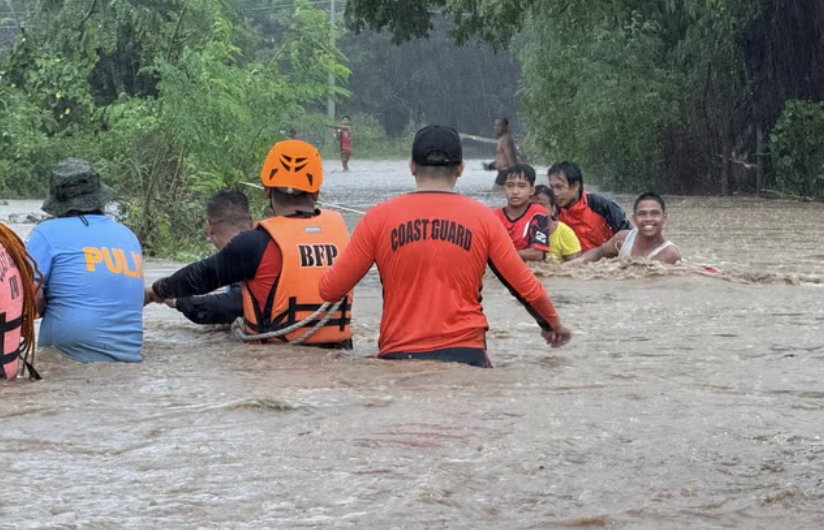Typhoon Krathon, a formidable storm system, is forecasted to make landfall in the Philippines, bringing with it a slew of severe weather conditions. As the latest in a series of extreme weather events, Krathon promises to test the resilience and preparedness of the nation’s citizens and infrastructure.
Storm Overview and Trajectory
The Philippines’ national weather service, PAGASA, issued urgent warnings as Typhoon Krathon intensified over the Pacific Ocean. According to meteorologists, the storm is expected to barrel towards the eastern coastline, impacting major islands such as Luzon and the Visayas within the next 48 hours.
As of the latest satellite imagery, Krathon was classified as a Category 4 typhoon, boasting sustained wind speeds of up to 215 km/h (134 mph) and occasional gusts surpassing 250 km/h (155 mph). These wind speeds place it perilously close to a Category 5 designation, the most powerful classification on the Saffir-Simpson scale.

Key Facts
- Date of Landfall: Expected within 48 hours
- Wind Speed: 215 km/h (134 mph) sustained, gusts over 250 km/h (155 mph)
- Affected Areas: Eastern Philippines, particularly Luzon and the Visayas
Expected Impact and Preparations
The impending arrival of Typhoon Krathon has set off alarm bells across the archipelago. Residents have been urged to brace for a deluge of calamities, including torrential rains, powerful winds, and life-threatening storm surges.
Primary Concerns
- Flooding: Heavy rainfall could lead to flash floods and landslides, particularly in coastal and mountainous areas.
- Storm Surges: Coastal regions face the threat of storm surges capable of inundating low-lying communities.
- Wind Damage: High-speed winds pose a significant risk to buildings, power lines, and trees, potentially leading to widespread power outages and structural damage.
Evacuation protocols are in place, and local authorities have been working round the clock to ensure that vulnerable populations are moved to safety. Emergency shelters have been stocked with essentials, including food, water, and medical supplies, to support those displaced by the storm.
Government and Public Response
The Philippine government has activated its disaster response units at both the national and local levels. The National Disaster Risk Reduction and Management Council (NDRRMC) has spearheaded efforts to prepare and respond to the impending crisis.
In a recent statement, President Marcos emphasized the importance of vigilance and community cooperation during these trying times. “The safety and well-being of our fellow Filipinos is paramount. We urge everyone to adhere to the advisories and cooperate with local authorities to ensure minimal loss of life,” he stated.

Local communities have also shown remarkable resilience and solidarity. Volunteers from various organizations are on the ground, assisting with preparations, distributing relief goods, and providing temporary shelter. Social media has become a vital tool for disseminating real-time information, ensuring that even those in remote areas are kept informed.
Comparisons to Past Typhoons
Typhoons are a common occurrence in the Philippines, with the country averaging 20 typhoons annually. However, Typhoon Krathon is shaping up to be one of the more severe storms in recent memory. Comparisons are already being drawn to Typhoon Yolanda (Haiyan) of 2013, which left a trail of devastation in its wake.
In terms of wind speed, Krathon is slightly less powerful than Yolanda but still poses significant risks. The lessons learned from previous typhoons have been instrumental in improving disaster preparedness and response mechanisms. Enhanced early warning systems, better infrastructure, and more robust evacuation plans are among the improvements implemented since past catastrophic events.
Technological Advances
The continuous advancements in weather prediction technology have provided the Philippines with a strategic advantage. Modern satellite imaging, real-time tracking, and predictive modeling have made it possible to issue timely warnings and take proactive measures.
Moreover, the increasing adoption of mobile technology and internet connectivity means that more Filipinos can receive alerts and updates in real-time. This has enabled faster dissemination of crucial information, potentially saving countless lives.
Hope Amidst Adversity
While Typhoon Krathon presents a formidable challenge, the collective efforts of the government, local communities, and international partners offer a glimmer of hope. The resilience and unity displayed by Filipinos in the face of adversity underscore the indomitable spirit of the nation.
As preparations continue and the storm’s landfall draws near, there remains a steadfast belief that the measures put in place will mitigate the impact. The storm serves as a stark reminder of the importance of preparedness, solidarity, and the unwavering human spirit.
In the face of Typhoon Krathon, the Philippines stands united, ready to weather the storm and emerge stronger on the other side. Together, they shall prevail, for even the fiercest storm cannot dim the resilience and unity of a nation.
Stay safe, Philippines. Help, hope, and healing are on the horizon.
One thought on “Typhoon Krathon Set to Strike Philippines with Severe Weather Impact”
Comments are closed.